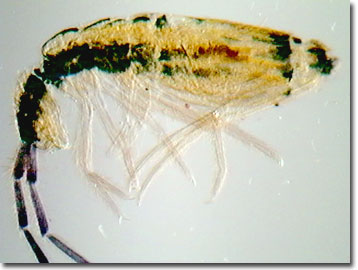Oblique Digital Image Gallery
Springtails
Primitive insects, springtails are minute, wingless members in the order Collembola. As the common name implies, springtails can leap or spring using a forked tail-like structure known as a furcula. A 5-millimeter springtail can jump up to 100 millimeters in one bound. Many springtails are beautifully colored and display a beautiful array of metallic greens, lavenders, and reds, but because of their minute size, largely go unnoticed.

Harmless to humans, springtails feed in the leaf litter on decaying plant matter, fungi, and bacteria helping to enrich the soil. Even though there are over 6,000 described species of Collembola worldwide, of which about 700 are found in North America, almost none exceed 1 millimeter in length.
Restricted to moist soil and litter conditions, springtails do not survive drought conditions. One species lives in the surface film of ponds and streams and occasionally is found in drinking water derived from wells or cisterns. When terrestrial populations boom in or near houses, they may alarm homeowners or create a visual nuisance, appearing as piles of "soot" in driveways, backyards, or basements. Some species are known as "snow fleas" since they are seen leaping about the top of snow during late winter or early spring.
Contributing Authors
Cynthia D. Kelly, Thomas J. Fellers and Michael W. Davidson - National High Magnetic Field Laboratory, 1800 East Paul Dirac Dr., The Florida State University, Tallahassee, Florida, 32310.
BACK TO THE OBLIQUE IMAGE GALLERY
BACK TO THE DIGITAL IMAGE GALLERIES
Questions or comments? Send us an email.
© 1995-2022 by Michael W. Davidson and The Florida State University. All Rights Reserved. No images, graphics, software, scripts, or applets may be reproduced or used in any manner without permission from the copyright holders. Use of this website means you agree to all of the Legal Terms and Conditions set forth by the owners.
This website is maintained by our
Graphics & Web Programming Team
in collaboration with Optical Microscopy at the
National High Magnetic Field Laboratory.
Last Modification Friday, Nov 13, 2015 at 02:19 PM
Access Count Since September 17, 2002: 17338
Visit the website of our partner in introductory microscopy education:
|
|
